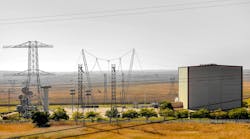Steven Ashby, Director of the Pacific Northwest National Laboratory, described how his organization has been working in collaborative efforts with industry, academic and other organizations in “developing and delivering new technologies and approaches to better measure, analyze, predict and control the electric power grid, adding that “long the way, we also are looking at ways to protect it from all kinds of risks, including cyber attacks.”
PNNL is based in Washington State, and Ashby referenced the recent PNNL work in an article he wrote for the Tri-City Herald, a local newspaper.
Ashby noted that just last month, one of PNNL’s experts testified before Congress about advanced cyber security technologies, sharing details “of how a voluntary information-sharing program among industry and the government allows a broad view of cyber threats across the system.”
By analyzing data collectively, Ashby points out that, “data makes it possible to quickly alert utilities of potential vulnerabilities.” He added that PNNLs researchers “are expanding this ‘cyber security situational awareness’ to develop an integrated, real-time view of utilities’ cyber risks.”
Beyond identifying risks to information technologies, PNNL is also “looking at risks to operational technologies, such as internal grid control system. Their efforts combine high-performance computing and machine learning techniques to analyze and spot trouble in the vast data streams generated by the growing number of intelligent devices on the grid. By quickly identifying trends and relationships in the data that may reveal a potential threat, grid operators and automated protection systems can rapidly take action to protect the grid.”
PNNL is also conducting research and developing technologies for the future defense of the grid. In a testament to the lab’s strength in this area, DOE recently selected us to lead six of 20 new grid cyber security research projects.
One of these projects aims to ensure the security of real-time information exchanges that will occur as new technologies are introduced to the “smart” grid. One such exchange might involve the use of transactive controls, where financial signals influence how and when energy is used.
Another information exchange might relate to how distributed resources, such as boxcar-sized batteries or intermittent solar and wind power might come on and off the grid as needs and availability vary.
Ashby’s article also mentions a palm-sized device called SerialTap, which was created by Pacific Northwest National Laboratory to protect older industrial control systems that cannot interact with today’s modern cyber security tools.
To protect these information exchanges, this project will enable a shift from digital signatures and encryption to a “keyless” solution. Much of today’s grid information security is based on technology akin to using a set of master keys to open all the doors across a large business complex. The keyless infrastructure solution being investigated will continuously monitor and autonomously verify the integrity of complex transactions — and do so with the security, speed and scale needed for the grid of the future. While this project focuses on existing systems, another seeks to build a partnership among suppliers and end users of energy to improve the security of new products before they ever go to market.
Ashby concluded that his examples give just a glimpse of PNNL’s research and development to create a more secure and resilient power grid.
The full Tri-City Herald Nov. 25, 2017 article is at this link.


